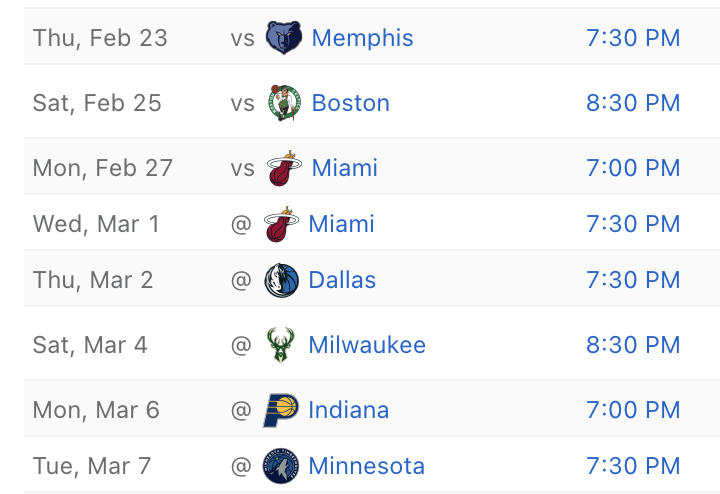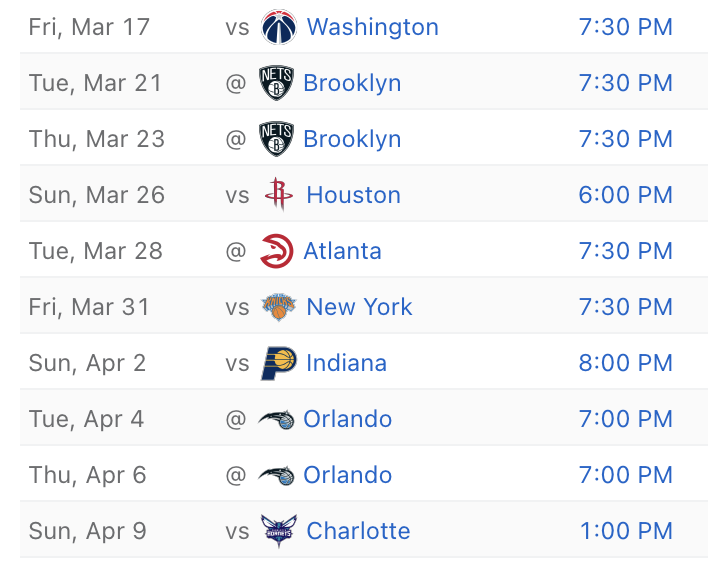Sizing up the schedules as the Cavs are set to battle for the third seed
You must have an active subscription to read this story.
Click Here to subscribe Now!
Danny Cunningham covers the Cleveland Cavaliers for 850 ESPN Cleveland and thelandondemand.com. You can find him on Twitter at @RealDCunningham.While the trade deadline last week was a quiet one for the Cleveland Cavaliers, it was a very busy one for the rest of the NBA. There were seismic moves made by teams the Cavs are competing with that will certainly have an impact on how the rest of the season – and postseason – looks for the Cavs.
The biggest move made in the NBA was one that certainly was a good thing for the Cavaliers postseason outlook. When the Brooklyn Nets traded Kevin Durant and T.J. Warren to the Phoenix Suns for a package of Cam Johnson, Mikal Bridges, Jae Crowder (who was later flipped to Milwaukee) and draft picks, the balance of power shifted in the Eastern Conference. The Nets went from a team that could make serious noise in the playoffs to a team that’s likely going to open up the playoffs on the road, if not in the NBA Play-In Tournament.
That alone creates more room for the Cavaliers. As play begins on Wednesday, the Cavs hold a 3.5-game lead over the Brooklyn Nets for the fourth seed in the Eastern Conference. Finishing in that position would mean homecourt advantage in the first round of the playoffs.
The real opportunity the Cavaliers have in the standings is to make their way up to the third seed by the end of the season. That’s a position currently held by the Philadelphia 76ers with a record of 37-19, a one-game lead over the 38-22 Cavaliers. These two teams are set to square off on Wednesday night in the final game prior to the All-Star break for each. This game, and the remaining two months of the season, will be potentially vital to the hopes for each to advance in the Eastern Conference playoffs.
Before diving any further into how this may play out, it needs to be mentioned that with the Nets no longer employing Durant and Kyrie Irving, the difficulty of the matchup between the four and five seeds has decreased, although it still is no cakewalk. No matter who ends up in third or fourth, both teams will be favored to win their respective series.
But Wednesday night’s game against the Sixers is an opportunity for the Cavs to begin a battle for the third seed, and thus a potentially easier matchup in the first round. A win for the Cavs would not only bring them into a virtual tie with the Sixers in the standings, but it would also clinch the season tiebreaker for Cleveland. That could be a big deal in mid-April.
What’s worth looking at while thinking about seeding is the schedules for these two teams the rest of the way.
As it stands now, the Cavaliers have the eighth-easiest schedule in the NBA between now and the end of the season with the winning percentage of the remaining opponents .487. The Cavs still have teams at the bottom of the standings like Houston, Detroit, Charlotte (three times), Orlando (twice), Indiana, and Washington on the schedule. There are certainly difficult games that remain, starting with Wednesday in Philadelphia, but overall the Cavaliers are in a good position to climb up the standings rather than fall any lower than fourth.
The Sixers are at the opposite end of the spectrum in this conversation. Their schedule is the most difficult remaining in the NBA, with their opponents winning percentage currently at .545. Aside from the two matchups with the Cavs, Philadelphia still has two games with Boston, two with Milwaukee, and games with the Nuggets and Grizzlies, too. In addition, the Sixers play 15 of their 25 games following the All-Star break on the road. Just by looking at those numbers, it becomes clear that the Cavaliers have a real chance to overtake the Sixers in the standings.
Where is becomes even more interesting is taking a look at exactly how the schedules play out over the last quarter of the season. There are two stretches for both the Cavs and the Sixers that could prove to be vital for the hopes of each team climbing the standings.
The first of those two stretches comes directly after the All-Star break. It’s one that isn’t an easy slate of games for either team, but may actually last a little bit longer for the Cavs. This could serve as Philadelphia’s chance to create a bit of distance in the standings between it and Cleveland, even if both schedules are comparable.
Following the break, seven of Cleveland’s first eight games come against teams that are currently in either the playoffs or the play-in. Only two of those games come against teams below .500, one game with Detroit and one against Toronto. This stretch ends with a pair of games in Miami against the Heat that could turn out to be relatively big games in the standings, too.

As for the Sixers, their first six games after the break come against playoff teams, but then go through a stretch of four games that aren’t nearly as difficult before their final matchup of the season against the Cavaliers in Cleveland on March 15.

The other stretches for these two teams is how the end of the season looks, most notably the last 10 days or so.
For the Cavs, their schedule really lightens up following that final game against the Sixers. After that night, they’ll have 10 regular season games remaining with just four of them against teams currently over .500, although two of those are against the Brooklyn Nets. The other two are in Atlanta and at home against the Knicks.

If the Cavs need to make up ground on the Sixers, the last five games of the season is the biggest opportunity to do so. The Cavs close the season with home games against the Knicks and Pacers before traveling to Orlando for a pair of games and closing the season at home against Charlotte.
There are a couple of things that make it difficult for Philadelphia down the stretch in comparison to the Cavs. After that game in Cleveland, the Sixers will have 14 games left on the schedule compared to the 10 remaining for Cleveland. Nine of those 14 games will be on the road, including a trip out west that includes a back-to-back in Golden State and Phoenix before stopping in Denver.

The schedule makers didn’t do the Sixers any favors on the way out, either. While the Cavs will have a handful of games that they’ll be heavy favorites in, the Sixers will be playing in Milwaukee, Atlanta, and Brooklyn, while Boston and Miami have dates in Philadelphia, too. That’s a really tough stretch to close things out.
All of these things point to a third-place finish for the Cavaliers, provided both teams stay healthy. According to basketball-reference.com’s playoff probability algorithm, the most likely place the Cavs end up is in third place, with a 41.6 percent chance to do so entering play on Wednesday. In fact, the projection has it more likely the Cavs end up in second place with a 23.5 percent chance than fourth place, with a 23.4 percent chance. That same model has the Sixers with a 51.8 percent chance to finish in fourth in the Eastern Conference.
Wednesday night in Philadelphia will go a long way towards deciding how this all plays out, but either way the Cavaliers are in a good spot with playoff positioning in mind.



